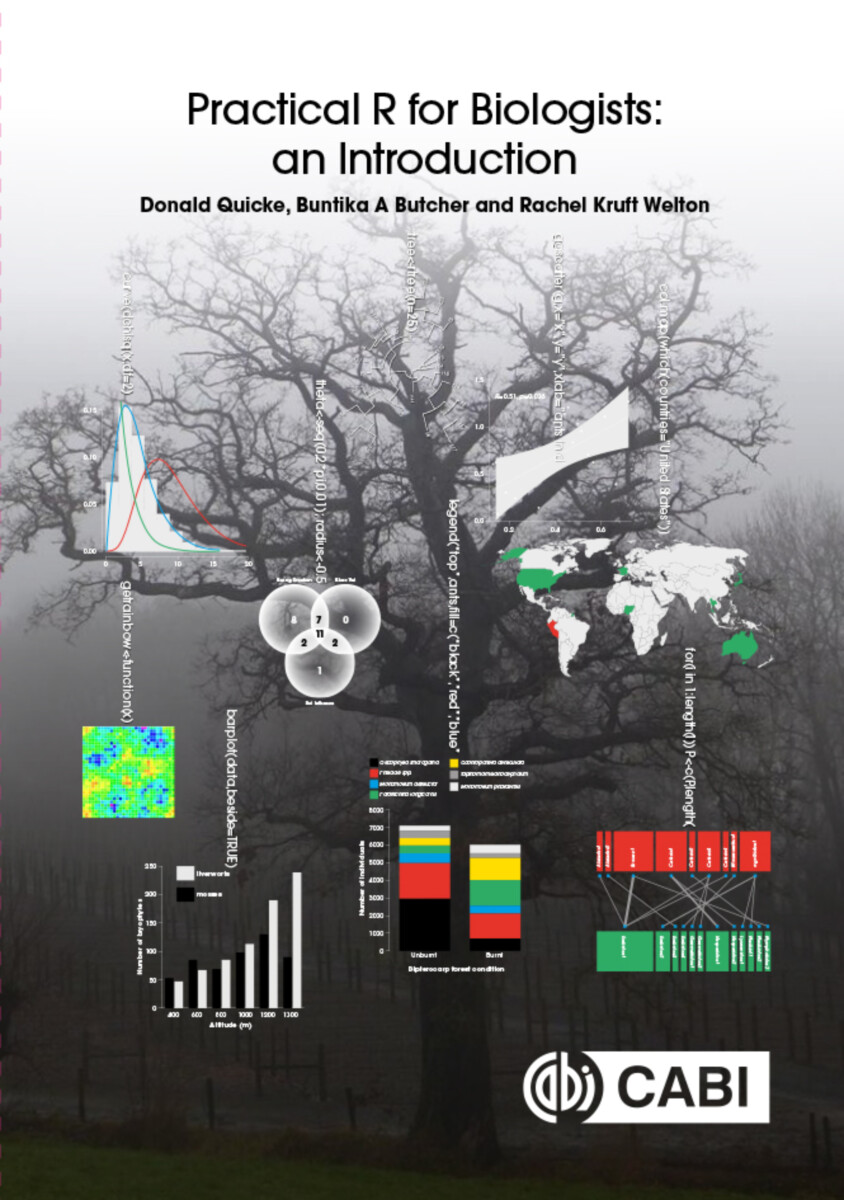Practical R for Biologists
An Introduction
- Publisher
CABI - Published
9th March 2021 - ISBN 9781789245349
- Language English
- Pages 400 pp.
- Size 6" x 9"
- Request Exam Copy
R is a freely available, open-source statistical programming environment which provides powerful statistical analysis tools and graphics outputs. R is now used by a very wide range of people; biologists (the primary audience of this book), but also all other scientists and engineers, economists, market researchers and medical professionals. R users with expertise are constantly adding new associated packages, and the range already available is immense.
This text works through a set of studies that collectively represent almost all the R operations that biology students need in order to analyze their own data. The material is designed to serve students from first year undergraduates through to those beginning post graduate levels. Chapters are organized around topics such as graphing, classical statistical tests, statistical modelling, mapping, and text parsing. Examples are based on real scientific studies, and each one covers the use of more R functions than those simply necessary to get a p-value or plot. The book walks the reader through the data analysis process, starting with very simple plots, and continuing through more complex analyses and programming. It shows how to deal with issues such as error messages that can be confronting for beginners, in order to set students up for a successful scientific career using R.
1: How to Use this Book
2: Installing and Running R
3: Very Basic R Syntax
4: First Simple Programs and Graphics
5: The Dataframe Concept
6: Plotting Biological Data in Various Ways
7: The Grammar of Graphics Family of Packages
8: Sets and Venn diagrams
9: Statistics: Choosing the Right Test
10: Commonly Used Measures and Statistical Tests
11: Regression and Correlation Analyses
12: Count Data as Response Variable
13: Analysis of Variance (ANOVA)
14: Analysis of Covariance (ANCOVA)
15: More Generalised Linear Modelling
16: Monte Carlo Tests and Randomisation
17: Principal Components Analysis
18: Species Abundance, Accumulation and Diversity Data
19: Survivorship
20: Dates and Julian Dates
21: Mapping and Parsing Text Input for Data
22: More on Manipulating Text
23: Phylogenies and Trees
24: Working with DNA Sequences and other character data
25: Spacing in Two Dimensions
26: Population Modelling Including Spatially Explicit Models
27: More on “apply” Family of Functions – Avoid Loops to get More Speed
28: Food webs and simple graphics
29: Adding Photographs
30: Standard Distributions in R
31: Reading and Writing Data to and from Files
Donald Quicke, PhD
Dr. Donald Quicke has had more than 40 years' experience teaching undergraduate and postgraduate biology students, initially at Sheffield University, UK and then at Imperial College London. He retired in 2013 and is now a teaching research fellow at the Department of Biology, Chulalongkorn University, Bangkok, Thailand. He co-authored Practical R for Biologists: An Introduction (2021). He is one of the world's leading experts on the taxonomy, systematics, and biology of parasitoid wasps.
Buntika A. Butcher, PhD
Dr. Buntika A. Butcher has worked on parasitoid wasps (plus some forensic entomology) since gaining her PhD in the Department of Biology, Imperial College London in 2004. On returning to Thailand she was appointed to a lectureship at Chulalongkorn University Bangkok and was subsequently promoted to Associate Professor in 2015. She has published more than 60 papers; co-authored Practical R for Biologists: An Introduction (2021); and has supervised numerous entomology students to masters and doctoral degree levels.
Rachel Kruft Welton, PhD
Dr. Rachel Kruft Welton got her master's degree at Imperial College, London and a PhD at University of Birmingham, UK before qualifying as a teacher. She has been a professional biology and science tutor for nearly 20 years, including mentoring undergraduates as part of Birmingham University's alumni scheme.


